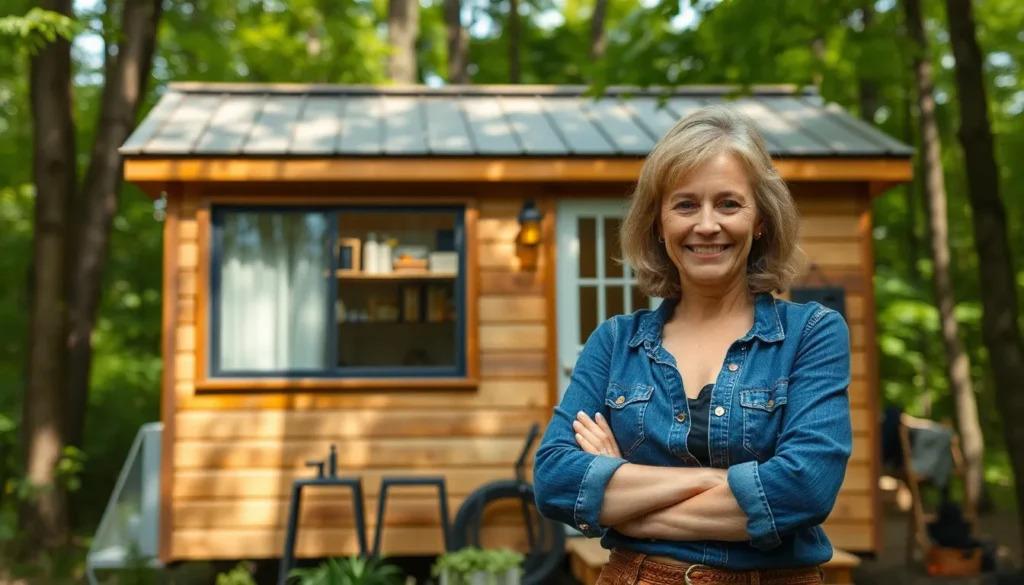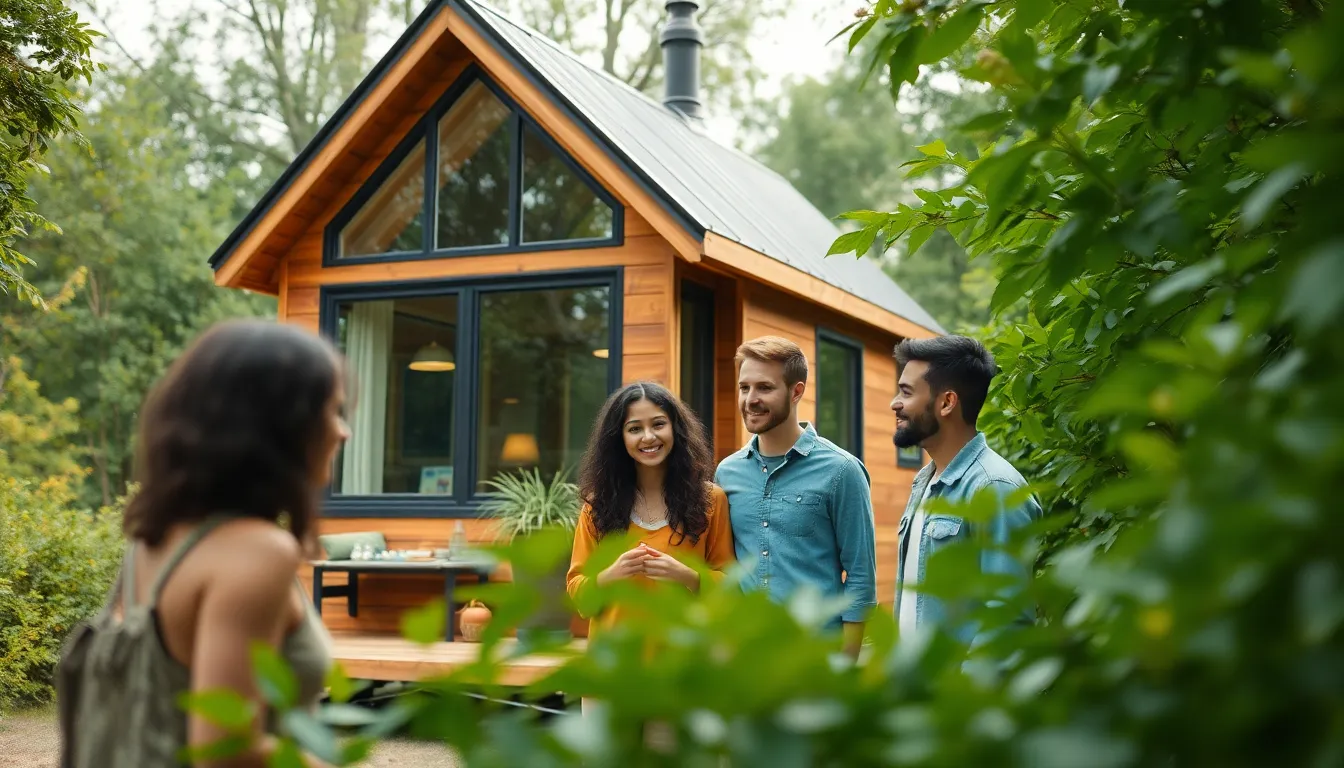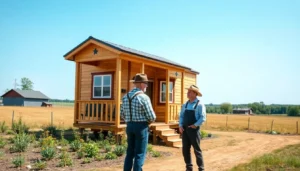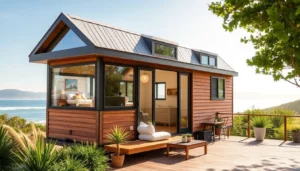Table of Contents
ToggleIn a world where bigger often seems better, tiny homes are flipping the script and proving that less can truly be more. These compact living spaces are popping up everywhere, capturing the hearts of minimalists and dreamers alike. Who knew that living in a shoebox could be so chic?
With innovative designs and clever storage solutions, tiny homes are redefining what it means to live large. Forget the mansion; it’s all about maximizing every square inch while keeping the clutter at bay. From eco-friendly materials to multifunctional furniture, the tiny home trend is not just a fad—it’s a lifestyle revolution that’s here to stay. So, whether you’re downsizing or just curious about the tiny life, buckle up for a delightful journey into the world of tiny home trends.
Overview of Tiny Home Trends
Tiny homes have gained significant popularity as people embrace smaller living spaces. Most individuals appreciate the affordability and sustainability that tiny homes offer. Environmental consciousness drives many to choose eco-friendly materials, encouraging a shift away from traditional housing.
Innovative designs become essential for maximizing space in these compact homes. Multi-functional furniture has seen increased use as homeowners seek to create versatile living environments. Many tiny home designs utilize vertical space, incorporating shelves and lofts to enhance storage options.
In addition, a growing number of communities focused on tiny living have emerged. These communities provide shared resources and foster connectivity among residents. They often feature communal areas, promoting interaction and collaboration.
The appeal of tiny homes also extends to those desiring mobility. Many opt for tiny houses on wheels, allowing for relocation without sacrificing comfort. This flexibility aligns with the desire for adventure and exploration in modern lifestyles.
As a result, tiny homes appeal to various demographics including millennials, retirees, and families. Diverse preferences for design aesthetics lead to a wide range of unique tiny home styles. From modern minimalist to rustic charm, these variations cater to distinct tastes and preferences.
The tiny home movement encourages simplicity and intentional living. Homeowners often report increased happiness and reduced stress levels after downsizing. This shift towards minimalism allows individuals to focus on meaningful experiences rather than material possessions.
Benefits of Tiny Living
Tiny living presents multiple advantages, appealing to those who seek a simpler lifestyle.
Financial Savings
Financial savings emerge as a prominent reason individuals opt for tiny homes. Lower mortgage payments or rental costs lead to reduced monthly expenses, making homeownership more attainable for many. Tiny homes often require less maintenance, cutting down on repair and upkeep costs. Property taxes can also decrease, which allows for greater flexibility in budgeting. Many homeowners report saving between 30% and 50% on housing costs compared to traditional homes. With fewer expenses, it becomes easier to allocate funds toward experiences and hobbies that enrich life.
Environmental Impact
Environmental impact plays a significant role in the appeal of tiny living. Smaller homes require fewer resources for construction, which conserves materials and reduces waste. Energy consumption typically declines, as tiny homes often utilize efficient heating and cooling systems. Many homeowners commit to using eco-friendly materials and sustainable practices in their designs. Consequently, this lifestyle supports a lower carbon footprint, contributing positively to the planet’s health. Residents of tiny home communities frequently prioritize shared resources, enhancing sustainability through collaboration and communal living.
Popular Designs and Styles
Tiny homes attract diverse styles that appeal to different preferences. A few popular designs dominate the market, enhancing the tiny living experience.
Modern Minimalism
Modern minimalism emphasizes clean lines and functionality. This design prioritizes simplicity, often featuring open floor plans that create an airy feel. Neutral color palettes lend a calming atmosphere, while large windows maximize natural light. Homeowners often choose sleek, modular furniture that serves multiple purposes, simplifying daily life. Incorporating smart storage solutions typically highlights this style, ensuring every inch of space remains organized. Additionally, modern minimalism reflects a lifestyle focused on living with less, promoting mindfulness and intentionality in home design.
Rustic Charm
Rustic charm embraces natural materials and cozy aesthetics. Wood beams frequently create warmth, while stone elements add character to tiny homes. Earthy tones and textured fabrics contribute to a homey ambiance, inviting relaxation. Often, these designs feature traditional layouts with creative space-saving solutions, such as built-in shelving and lofted sleeping areas. Homeowners appreciate the connection to nature that rustic charm offers, enhancing the overall living experience. Emphasizing handmade craftsmanship, these homes tell a story of simplicity and the beauty of the outdoors.
Tiny Home Communities
Tiny home communities are on the rise, creating spaces where residents embrace minimalism and sustainable living. These communities foster connections among like-minded individuals, enhancing the overall appeal of tiny living.
Notable Examples
Several tiny home communities stand out. One notable example, Eco Village in Ithaca, New York, features homes built with eco-friendly materials, encouraging sustainability. Another community, Tiny House Village in Atlanta, Georgia, offers residents a vibrant atmosphere focused on communal activities. Residents often participate in workshops and events, fostering camaraderie. Each community showcases diverse designs and layouts, catering to various lifestyles.
Community Benefits
Shared resources play a significant role in tiny home communities. Residents often share amenities like gardens, laundry facilities, and communal spaces, reducing individual costs. Lower maintenance expenses frequently arise due to shared responsibilities, allowing residents to allocate funds toward experiences. Community engagement enhances social well-being, as friendships form easily in these close-knit environments. Environmental benefits also emerge, with smaller footprints and collective efforts toward sustainability.
Challenges of Living Tiny
Living in a tiny home presents unique challenges that homeowners often face. Limited space requires careful planning and creativity in daily living.
Space Limitations
Space limitations significantly impact storage and functionality in tiny homes. Residents often find themselves needing to downsize their belongings, which can be emotionally challenging. Innovative storage solutions, like lofted beds and built-in furniture, help maximize available area. Homeowners frequently adopt a minimalist mindset, prioritizing necessities over excess. Bathrooms and kitchens, in particular, may feel cramped, necessitating efficient layouts. Unquestionably, effective organization is key for maintaining a clutter-free environment. Many individuals find joy in simplicity, deriving satisfaction from the merits of compact living.
Zoning Regulations
Zoning regulations pose a substantial hurdle for tiny home enthusiasts. Many areas impose restrictions on the size and placement of homes, complicating the building process. Compliance with local codes can delay construction and increase costs. Individuals often need to navigate a maze of permits and inspections before moving in. Some regions may lack infrastructure suited for tiny home communities, limiting options for potential residents. Local governments may view tiny homes skeptically, associating them with transient living. Discovering supportive municipalities is crucial for aspiring tiny homeowners committed to making the transition. Each jurisdiction has its own set of rules, so research becomes essential for successful implementation.
Conclusion
Tiny homes represent a transformative shift in how people view living spaces. This movement embraces not just smaller living but a lifestyle that prioritizes sustainability and community. As more individuals discover the benefits of affordability and reduced environmental impact, tiny homes are likely to continue gaining traction.
The innovative designs and collaborative living arrangements foster a sense of connection among residents while promoting eco-friendly practices. Despite the challenges of space and regulations, the tiny home trend invites everyone to rethink their relationship with material possessions and find joy in simplicity. With each tiny home built, a new chapter in sustainable living unfolds, encouraging a more intentional approach to life.








